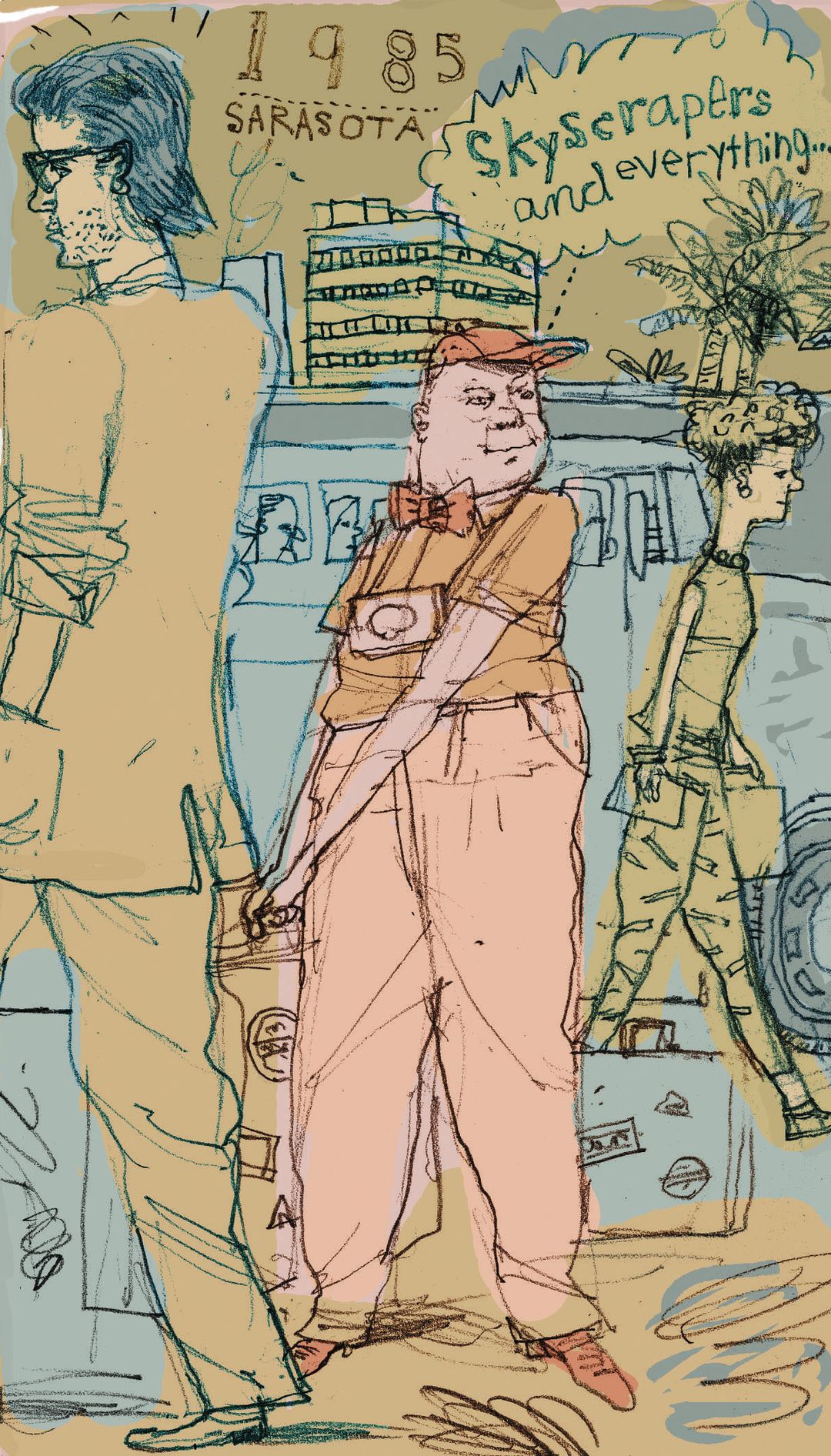The Way We Were: Mr. Chatterbox, John D. MacDonald and the Herald-Tribune

Image: Regan Dunnick
I’m starting to feel a little guilty for all those cracks I’ve been making about the Herald-Tribune lately. True, it is shrinking and the writing is getting kind of pedestrian. And that paywall they put up to force you into a subscription is infuriating. But I shouldn’t complain. After all, the Herald-Tribune gave me my life and career in Sarasota.
Let’s go back to 1985, when I first moved here. I was looking for a quiet place to finish a book I was working on, and Sarasota seemed a logical, rather romantic place for such a task. Everything I knew about the town came from books—specifically those of my favorite author, John D. MacDonald. I loved his mystery novels about shady characters plotting schemes in a steamy tropical atmosphere.
I didn’t know a soul in town, and I admit my first reaction was a bit of a disappointment. There certainly didn’t seem to be any shady—or even colorful—characters around. The typical resident was a widow in her 70s from Indiana. The whole town was built to accommodate her and her needs, and no business could flourish without her patronage. I had not yet turned 40 and seemed freakishly young to this crowd. Younger people did exist, true, but to my New York City eyes they were beaten-down losers, stuck in a backwater like characters in a Chekhov play.
Everything seemed a little second-rate. There was only one decent hotel, the Colony on Longboat Key. Good restaurants were hard to find. People went to the Colony for brunch on Sunday, and there was Euphemia Haye and the Columbia, but the only place on the mainland that had a touch of glamour was the St. Georges (whose space in Bay Plaza, in a strange twist of fate, now houses the offices of Sarasota Magazine). Shopping was restricted to a couple of rather ordinary department stores like Burdines and Maas Brothers, with the specialty stores on St. Armands a little more upscale, at least for the widows.
You heard a lot about the famous arts scene. Then as now, Sarasota billed itself the arts capital of Florida. But for my jaded taste, the pickings were pretty slim. Oh, there was enough going on but not much that was first-rate and virtually nothing original. The plays and concerts were copies of things done elsewhere.
There was one major exception: the remnants of the artist colony that flourished here from the late 1940s. These characters were colorful, and they gave the town an intellectual reputation. Today most of them are forgotten, but back then they were quite prominent writers and painters of the day, many with national reputations. As far as I could tell, most of them lived out at the beach and drank a lot and swapped wives. I was dying to get to know them.
But how? I knew no one. Just the clerk at the Short Stop and a guy named Bill who ran the video rental store. I needed a plan.
One extraordinary thing Sarasota had back in those days was a wonderful daily newspaper, and it was the keyhole I peeked through. The Herald-Tribune handled the world and national news just fine, but it was the depth with which it described Sarasota that made it so valuable. And in between the news about the county commission and the school board, there was a darkness here—a wealthy widow dies in a mysterious fire in her beachfront mansion, a doctor murders his wife, two baby girls are switched at birth out in Wauchula.
The paper’s writers were remarkable. There was a young theater critic named Jay Handelman who was bringing a sophisticated point of view to what was basically small-town theater. Joan Altabe covered the visual arts; she was the critic everybody loved to hate (and ended up immortalized in Stephen King’s Duma Key because of it). There was also a full-time humor columnist named David Grimes and two society columnists—Helen Griffith, who was sweet and covered the widows beautifully, and a much younger and tougher go-getter named Marjorie North.
But my favorite writer was the guy who handled the arts coverage. His name was Charlie Huisking, and he had the magic touch. His interviews were full of illuminating details and really made his subjects come to life. In a moment of inspiration, I called my publisher in New York and told him to get me interviewed by Charlie.
I guess back in those days the editors were desperate for a little novelty. Charlie came over and wrote a story about me, making me sound much better than I really was, but still making it believable. The paper put it on the front page of the feature section, with a great picture of me standing next to my pool. I’d been in Sarasota a month and I had already arrived.
But the paper’s real importance to American literature wasn’t revealed until a little later. As a result of the article, I was invited to join the famous Liar’s Club, the group of writers and artists who met weekly for lunch and a game of Liar’s Poker at Merlin’s Restaurant downtown. This was the group I wanted to meet—the cream of Sarasota’s artistic elite.
I was nervous as I showed up for my first lunch. I walked into Merlin’s and saw them, perhaps 10 or 12, all men (“no women” was their strictest rule). They were seated at a back table and already well into their first drink. I could pick out Joe Hayes, the playwright and author of The Desperate Hours, Dik Browne, the cartoonist who created Hagar the Horrible, and yes, there he was—my idol, John D. MacDonald.
It took me a couple of lunches to get a seat right next to him, but I finally did. He was rather ordinary in appearance, silver hair thinning a bit, and big dark-rimmed glasses. We hit it off, I’m glad to say. We talked about all sorts of things: drug smuggling, banking scams, the best hotel in Mexico City. He was everything I hoped he would be: smart, self-deprecating, funny, and with a strong moral compass.
There was so much I wanted to know from him, but the most important was this: Where did he get all that wonderful material? How did he come up with the schemes and plots, the sun-bleached atmosphere, the amoral men, the damaged women?
“Do you do research?” I asked. “Do you drive around the state? Do you talk to people in bars? Where do you get your ideas?”
He chuckled and took another sip of his Bloody Mary. “It’s very simple,” he said and leaned closer to my ear. “I just read the Herald-Tribune.”
To me, that will always be the paper’s greatest accomplishment—serving as literary muse to Florida’s greatest storyteller.



